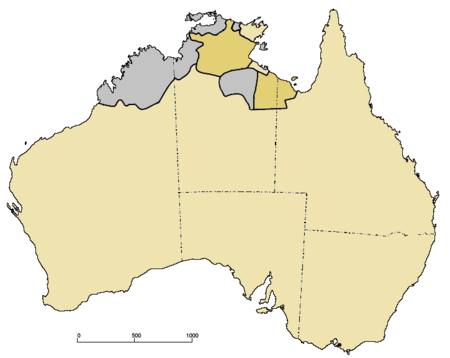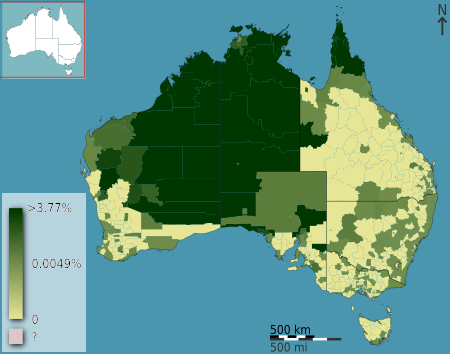Australian Aboriginal languages
The Indigenous languages of Australia are spoken by the First Peoples of mainland Australia and nearby islands. There were once hundreds of these languages, possibly as many as 363! Today, many are sadly endangered.
Most Australian languages belong to a large group called the Pama–Nyungan family. The other languages, found mostly in the far north, are called "non-Pama–Nyungan." This just means they are not part of the Pama–Nyungan group.
In the late 1700s, there were more than 250 different First Nations Peoples groups and about the same number of languages. As European settlers arrived, many languages disappeared. This happened because Indigenous cultures were broken up. For some of these lost languages, we have very few records of their words or grammar.
At the start of the 21st century, fewer than 150 Aboriginal languages were still used daily. Most of these are highly endangered. By 2020, 90% of the over 100 languages still spoken were considered endangered. Only 13 languages are still being taught to children. The languages that have survived are mostly in very isolated areas.
Some Yolŋu languages from north-east Arnhem Land are still learned by children today. Bilingual education, where children learn in two languages, is working well in some communities. Seven of the most widely spoken Australian languages, like Warlpiri, Murrinh-patha, and Tiwi, still have between 1,000 and 3,000 speakers. Many Indigenous communities and language experts are working to bring back lost languages or help people learn some words and ideas from them.

Contents
Living Aboriginal Languages
The National Indigenous Languages Survey checks the health of Aboriginal and Torres Strait Islander languages regularly. It was done in 2005, 2014, and 2019.
Here are some languages with more than 100 speakers:
- In the Northern Territory, there are 19 languages with about 28,100 speakers. Some of the biggest are:
* Upper Arrernte (~4,500 speakers) * Warlpiri (~2,300 speakers) * Murrinh Patha (~2,000 speakers) * Tiwi (~2,000 speakers) * Kunwinjku (~1,800 speakers) * Anindilyakwa (~1,500 speakers) * Luritja (~1,000 speakers) * Burarra (~1,000 speakers)
- In Western Australia, there are 17 languages with about 8,000 speakers. Some of the biggest are:
* Ngaanyatjarra (~1,000 speakers) * Martu Wangka (~700 speakers) * Noongar (~500 speakers) * Yinjibarndi (~400 speakers) * Bardi (~400 speakers)
- In South Australia, there are 4 languages with about 3,900 speakers. The largest is Pitjantjatjara (~3,100 speakers, also spoken in NT and WA).
- In Queensland, there are 5 languages with about 1,800 speakers. Some examples are Guugu Yimidhirr (~800 speakers) and Wik Mungkan (~400 speakers).
- In New South Wales, there are 3 languages with about 600 speakers. These include Wiradjuri (~500 speakers) and Gamilaraay (~100 speakers).
- Victoria and Tasmania have no languages with over 100 speakers.
Overall, there are 46 languages with at least 100 speakers, totaling about 42,300 speakers. Eleven of these languages have over 1,000 speakers.
There are also Creole languages, which are new languages that developed from a mix of different languages. One example is Kriol, spoken by about 20,000 people.
How Languages are Grouped
Inside Australia
Most Australian languages belong to the Pama–Nyungan family. This is a very large group that covers most of Australia. Some experts believe all Australian languages might have come from one very old language spoken about 12,000 years ago in northern Australia.
The other languages, found mostly in the far north, are called "Non-Pama–Nyungan." They are different from the Pama–Nyungan languages. Some linguists think these northern languages might have arrived more recently from nearby islands.
Outside Australia
For a long time, people tried to find a link between Australian languages and Papuan languages, which are spoken in nearby New Guinea. Australia and New Guinea were once connected as one big landmass called the Sahul continent. They were only separated by the Torres Strait about 8,000 years ago. This means that some languages from both places might share very old connections.
Language Families
Experts group Australian languages into many different families and also some "isolates." An isolate is a language that doesn't seem to be related to any other known language. For example, the Tiwi language is an isolate.
Survival of Languages
It is thought that before European settlement, each of the 250 languages might have had 3,000 to 4,000 speakers on average. Many of these languages were lost very quickly after colonization. The Aboriginal Tasmanians are a sad example of this. Tasmania was separated from the mainland about 12,000 years ago. Indigenous Tasmanians lived isolated for a very long time. Studies suggest there were 12 Tasmanian languages, and they were not clearly related to mainland Australian languages.
By 1990, it was estimated that only 90 languages survived. Many were disappearing as older speakers passed away. By 2001, 70% of these 90 languages were "severely endangered." Only 17 were still spoken by people of all ages. Experts worry that many more languages will disappear in the next generation, possibly by 2050. When a language is lost, the cultural knowledge it carries is also lost.
During the period of the Stolen Generations, Aboriginal children were taken from their families. In the places they were sent, they were often punished for speaking their Indigenous languages. Different language groups were mixed, and Australian Aboriginal English or Australian Kriol language became the only way for them to communicate. This stopped languages from being passed down from parents to children.
Today, passing language from parents and grandparents to children is key to bringing languages back. For children, knowing their cultural language helps them form their identity. It is also thought to be good for the emotional well-being of Indigenous children.
Indigenous languages have even been spoken in the Australian Parliament! Aden Ridgeway spoke in an Indigenous language in the Australian Senate in 1999. In 2016, Linda Burney gave a welcome in Wiradjuri in the Australian House of Representatives.
Efforts to Preserve Languages
The year 2019 was the International Year of Indigenous Languages (IYIL2019). This was declared by the United Nations General Assembly. It helped raise awareness and support for preserving Aboriginal languages in Australia. People learned how important each language is to the identity and knowledge of Indigenous groups.
Many people are working to preserve languages. For example, Troy Wyles-Whelan has been collecting oral histories and research for the North Queensland Regional Aboriginal Corporation Language Centre. To help the Wiradjuri language, a Grammar of Wiradjuri language was published in 2014 and A new Wiradjuri dictionary in 2010.
The New South Wales Aboriginal Languages Act 2017 became law in 2017. It was the first law in Australia to recognize how important First Languages are.
In 2019, the Royal Australian Mint made a special 50-cent coin for the International Year of Indigenous Languages. It features 14 different words for "money" from Australian Indigenous languages.
Old word lists created by ethnographer Daisy Bates in the 1900s are being digitized. This is a valuable resource for people researching languages, especially from Western Australia, the Northern Territory, and South Australia. This work helps make old records available online.
Bringing Languages Back
In recent years, there have been efforts to revive Indigenous languages. This means bringing languages back into use that were no longer spoken. It is a big challenge because English is the main language in Australia.
The Kaurna language, spoken by the Kaurna people of the Adelaide plains, is a great example. A strong effort to revive it started in the 1980s. The last known speaker died in 1931. However, many old records of the language existed. From these records, the language has been rebuilt.
Common Features of Australian Languages
Australian languages share many features, even if they are not closely related. They often have similar words and sounds.
Many Australian languages have "avoidance speech." This is a special way of speaking used only when certain close relatives are present. The grammar is the same, but the words are different and usually very limited. There are also often speech taboos during times of mourning or initiation. This has led to many Australian Aboriginal sign languages.
Sounds and Pronunciation
A typical Australian language has only three vowel sounds: i, u, and a. These can be long or short.
One striking thing about Australian languages is the large number of places in the mouth where sounds are made. For example, they often have four different "coronal" sounds, made with the front part of the tongue. This is very different from most languages around the world, which usually have only one.
Australian languages usually do not have sounds like f or s. They also rarely have sounds where you can tell the difference between a "p" and a "b" just by how much your vocal cords vibrate.
Some experts have suggested that the unique sounds in Australian languages might be linked to high rates of ear infections (otitis media) and hearing loss in some Aboriginal communities. People with hearing loss sometimes find it hard to hear certain sounds. Australian languages seem to avoid those difficult sounds and instead use sounds that are easier to hear for people with hearing loss. However, this idea has been questioned by other researchers.
How Languages are Written
Almost every Australian language that still has speakers has a way of being written down. They all use the Latin alphabet, which is the same alphabet English uses.
Sounds not found in English are often shown using two letters together (like "nh" for a dental 'n') or with special marks (like an underline for a retroflex 'n'). Sometimes, symbols from the International Phonetic Alphabet are used, like ŋ for the 'ng' sound in "sing."
| Language | Example | Translation | Type |
|---|---|---|---|
| Pitjantjatjara | paṉa | 'earth, dirt, ground; land' | diacritic (underline) indicates retroflex 'n' |
| Wajarri | nhanha | 'this, this one' | digraph indicating 'n' with dental articulation |
| Yolŋu | yolŋu | 'person, man' | 'ŋ' (from IPA) for velar nasal |
Who Speaks Indigenous Languages (2016)
In 2016, 62.5% of Aboriginal Australians in the Northern Territory spoke an Indigenous language at home. In Queensland, almost 95% of Torres Strait Islanders spoke an Indigenous language at home.
| Place | Population that speaks an Indigenous language | Percentage that speaks an Indigenous language |
|---|---|---|
| Torres Strait Islands | 3,159 | 69.9% |
| 34,956 | 15% | |
| 10,251 | 0.4% | |
| 13,474 | 0.3% | |
| 3,392 | 0.2% | |
| 1,922 | 0% | |
| 526 | 0% | |
| 132 | 0% | |
| 70 | 0% |
Notable Linguists
Many linguists and researchers have greatly helped us understand Australian languages. Some important ones include:
- Barry Blake
- Claire Bowern
- Gavan Breen
- Arthur Capell
- R. M. W. Dixon
- Kenneth Hale
- Margaret Heffernan
- Luise Hercus
- David Nash
- Lynette Oates (1921–2013)
- Nicholas Evans
- Rachel Nordlinger
See Also
 In Spanish: Lenguas aborígenes de Australia para niños
In Spanish: Lenguas aborígenes de Australia para niños
- Aboriginal Australians
- Australian Aboriginal sign languages
- List of Australian Aboriginal group names
- List of Australian Aboriginal languages
- List of Aboriginal languages of New South Wales
- List of Australian place names of Aboriginal origin
- List of endangered languages with mobile apps
- List of reduplicated Australian place names
- Living Archive of Aboriginal Languages
- Macro-Gunwinyguan languages
- Macro-Pama–Nyungan languages



